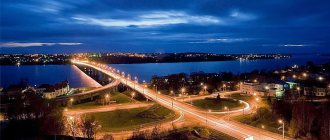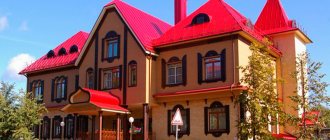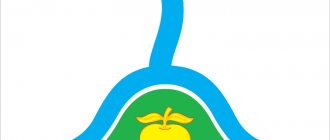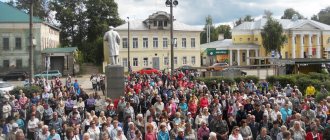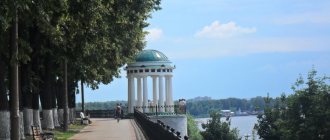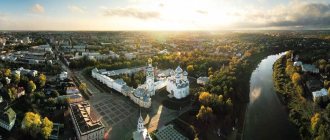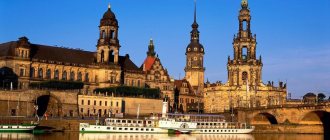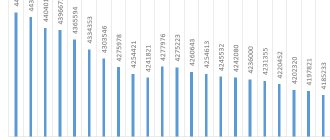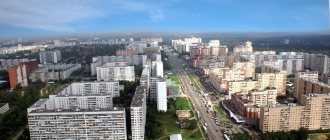The Kostroma region belongs to the Central Federal District. The population here, according to data for 2022, is 637 thousand people, with negative growth observed. The population density is approximately 10.6 people per 1 m². According to 2022 data, almost 73% of the population belongs to urban areas. In terms of national composition, there is the greatest diversity in this part of Russia: a total of 114 nationalities are represented. However, most of all in the territory of this subject of the Russian Federation there are Russians - 97%.
The population can be presented as a list according to the criterion of ability to work (by age). The picture turns out to be alarming:
- The working population is 60%.
- Younger than able-bodied – about 16%.
- Older - approximately 25%.
Development of the Kostroma region
The regional administration recognizes the existing demographic problem. The region has powerful potential. A railway line passes through it, connecting Moscow and Vladivostok. The largest highways intertwining the northwestern part of the state are also laid here. Waterways are also functioning.
The Kostroma region traditionally belongs to industrial-agrarian regions. In recent years, under the program for the resettlement of compatriots, specialists who are able to support the development of agriculture and forestry in the region have been actively attracted here. This subject of the Russian Federation has quite good potential in the field of mechanical engineering and in the creation of high-quality textiles. However, at the moment everything needs development.
There are a number of projects aimed at attracting more investment to the region. Some of them are betting on the development of a powerful transport system, thanks to which the Kostroma region should benefit. Another project “Kostroma - the soul of Russia” is focused on the tourism sector. Its authors point to the great recreational potential of the region, as well as a huge number of architectural attractions that can be restored.
Notes
- ↑ 12
The edges Altai • Transbaikal • Kamchatka • Krasnodar • Krasnoyarsk • Perm • Primorsky • Stavropol • Khabarovsk Regions Amur • Arkhangelsk • Astrakhan • Belgorod • Bryansk • Vladimir • Volgograd • Vologda • Voronezh • Ivanovo • Irkutsk • Kaliningrad • Kaluga • Kemerovo • Kirov • Kostroma • Kurgan • Kursk • Leningrad • Lipetsk • Magadan • Moscow • Murmansk • Nizhny Novgorod • Novgorod • Novosibirsk • Omsk • Orenburg • Oryol • Penza • Pskov • Rostov • Ryazan • Samara • Saratov • Sakhalin • Sverdlovsk • Smolensk • Tambov • Tver • Tomsk • Tula • Tyumen • Ulyanovsk • Chelyabinsk • Yaroslavl Federal cities Moscow • St. Petersburg • Sevastopol[1] Autonomous region Jewish Autonomous okrugs Nenets[2] • Khanty-Mansiysk - Yugra[3] • Chukotka • Yamalo-Nenets[3] - ↑ 12
The Republic of Crimea and Sevastopol are located on territory whose annexation to Russia has not received international recognition. - Part of the Arkhangelsk region
- ↑ 12
Part of the Tyumen region
- ↑ 12
Kostroma is a proud city with proud residents
Kostroma is a city of regional significance, the largest in the region with a population of 277 thousand people. It is also one of the oldest settlements in the region, founded in 1152 in Russia. Kostroma is also the largest river port on the Volga.
It should be noted that the great potential of the city attracted migrants here from other regions in the period from 2012 to 2022 inclusive. The titular nation predominates in the city: the number of Russians, according to the latest data, is about 96%.
Kostroma has strong investment potential, as it is an ancient center of the flax industry. It is also very interesting from the point of view of tourism development. In particular, the historical center with buildings in the spirit of classicism of the 18th-19th centuries is perfectly preserved here.
Visitors like not only the rich history of Kostroma, but also the fairly favorable environmental situation. The climate here is continental, but it is quite moderated thanks to the air masses that come from the Atlantic Ocean. Plus, the proximity of the Volga and the Kostroma River has an effect.
Small towns up to 20 thousand people
Galich
Population 16,927 people (2016).
Volgorechensk
Population 16,701 people (2016).
Manturovo
Population 15,804 people (2016).
Not me
Population 9,001 people (2016).
Makariev
Population 6,695 people (2016).
Soligalich
Population 6,023 people (2016).
Chukhloma
Population 5,046 people (2016).
Kologriv
Population 3,067 people (2016).
Sharya is a small town in the region
The population of the Sharya urban district is 35.8 thousand. However, the number of residents of the settlement itself is much smaller - only 24 thousand. However, this still makes the city one of the largest in the region. Sharya is also one of the few settlements in the region that can boast that the population has increased in some years after 2010.
Life in Sharya is largely centered around the largest railway junction of the Trans-Siberian Railway. The woodworking industry is also very well developed here; there is a large complex here. Thanks to him, timber industry enterprises, which in 2000 found themselves bankrupt, began to revive. In recent years, a furniture manufacturing enterprise has opened. The food industry is also developing: there is a mineral water production plant. All this became the reason for the revival of the region.
National composition
| 1959[41] people | % | 1979[42] people | % | 1989[43] people | % | 2002[44] people | % from everything | % of those who indicated nationality | 2010[45][46] people | % from everything | % of those who indicated nationality | |
| Total | 919999 | 100,00 % | 802420 | 100,00 % | 804296 | 100,00 % | 736641 | 100,00 % | 667562 | 100,00 % | ||
| Russians | 898263 | 97,64 % | 781997 | 97,45 % | 774620 | 96,31 % | 704049 | 95,58 % | 96,34 % | 622444 | 93,24 % | 96,60 % |
| Ukrainians | 7054 | 0,77 % | 7631 | 0,95 % | 9723 | 1,21 % | 8011 | 1,09 % | 1,10 % | 5650 | 0,85 % | 0,88 % |
| Tatars | 3593 | 0,39 % | 3053 | 0,38 % | 2965 | 0,37 % | 2731 | 0,37 % | 0,37 % | 2224 | 0,33 % | 0,35 % |
| Armenians | 326 | 0,04 % | 252 | 0,03 % | 565 | 0,07 % | 1462 | 0,20 % | 0,20 % | 1656 | 0,25 % | 0,26 % |
| Gypsies | 877 | 0,10 % | 1219 | 0,15 % | 1412 | 0,18 % | 1542 | 0,21 % | 0,21 % | 1519 | 0,23 % | 0,24 % |
| Belarusians | 2365 | 0,26 % | 2500 | 0,31 % | 2891 | 0,36 % | 2354 | 0,32 % | 0,32 % | 1490 | 0,22 % | 0,23 % |
| Azerbaijanis | 218 | 0,02 % | 206 | 0,03 % | 994 | 0,12 % | 1438 | 0,20 % | 0,20 % | 1291 | 0,19 % | 0,20 % |
| Moldovans | 206 | 0,02 % | 575 | 0,07 % | 1606 | 0,20 % | 1036 | 0,14 % | 0,14 % | 859 | 0,13 % | 0,13 % |
| Chuvash | 953 | 0,10 % | 825 | 0,10 % | 1171 | 0,15 % | 943 | 0,13 % | 0,13 % | 748 | 0,11 % | 0,12 % |
| Uzbeks | 126 | 0,01 % | 140 | 0,02 % | 407 | 0,05 % | 295 | 0,04 % | 0,04 % | 515 | 0,08 % | 0,08 % |
| Germans | 1727 | 0,19 % | 427 | 0,05 % | 450 | 0,06 % | 658 | 0,09 % | 0,09 % | 427 | 0,06 % | 0,07 % |
| Georgians | 322 | 0,04 % | 127 | 0,02 % | 545 | 0,07 % | 546 | 0,07 % | 0,07 % | 390 | 0,06 % | 0,06 % |
| Lezgins | 38 | 0,00 % | 329 | 0,04 % | 282 | 0,04 % | 0,04 % | 360 | 0,05 % | 0,06 % | ||
| Dargins | 22 | 0,00 % | 318 | 0,04 % | 274 | 0,04 % | 0,04 % | 301 | 0,05 % | 0,05 % | ||
| Ingush | 62 | 0,01 % | 359 | 0,04 % | 345 | 0,05 % | 0,05 % | 284 | 0,04 % | 0,04 % | ||
| Chechens | 35 | 0,00 % | 531 | 0,07 % | 467 | 0,06 % | 0,06 % | 275 | 0,04 % | 0,04 % | ||
| Mordva | 738 | 0,08 % | 321 | 0,04 % | 464 | 0,06 % | 358 | 0,05 % | 0,05 % | 258 | 0,04 % | 0,04 % |
| Avars | 51 | 0,01 % | 312 | 0,04 % | 243 | 0,03 % | 0,03 % | 257 | 0,04 % | 0,04 % | ||
| Tajiks | 17 | 0,00 % | 133 | 0,02 % | 129 | 0,02 % | 0,02 % | 240 | 0,04 % | 0,04 % | ||
| Yazidis | 10 | 0,00 % | 196 | 0,03 % | 0,03 % | 216 | 0,03 % | 0,03 % | ||||
| other | 3218 | 0,35 % | 2922 | 0,36 % | 4490 | 0,56 % | 3420 | 0,46 % | 0,47 % | 2964 | 0,44 % | 0,46 % |
| indicated nationality | 919986 | 100,00 % | 802420 | 100,00 % | 804295 | 100,00 % | 730779 | 99,20 % | 100,00 % | 644368 | 96,53 % | 100,00 % |
| did not indicate nationality | 13 | 0,00 % | 0 | 0,00 % | 1 | 0,00 % | 5862 | 0,80 % | 23194 | 3,47 % |
Bui is another small town
The population of the city of Bui is 24 thousand. Negative growth has been observed since 2011; before that there was a positive trend. The city is located 103 km from Kostroma. The settlement arose thanks to the fortress, which was erected in 1536.
Bui now lives primarily from the timber and pulp industries. They also plan to build the Kostroma nuclear power plant next to it. Bui is quite interesting for its history and cultural monuments.
What does the state do
Since 2007, in the Kostroma region, as throughout Russia, the State Support for Families Program has been implemented. State policy aimed at solving the demographic problem is aimed at increasing the birth rate through material assistance to young families and obtaining a loan for maternity capital for these purposes, with which this loan will subsequently be paid in full or in part. The reform of the maternity capital program in 2022 is aimed at strengthening the institution of family .
Nerekhta - a regional pearl
Nerekhta is one of the most ancient settlements in the region. It was known back in 1214, when the heirs of Vsevolod the Big Nest began to fight for it. The total population is 21 thousand. Historically, the city developed thanks to salt mining. Now Nerekhta is interesting primarily for its large number of architectural monuments, a significant part of which are occupied by various churches and monasteries.
The relatively calm crime situation and environmental well-being speak in favor of relocating to the city of Nerekhta. There is also quite affordable housing here. Nerekhta is connected to Moscow by railway. To get from here to the capital, you need to spend about 5 hours on the road.
However, the population is constantly decreasing. This is due to the lack of work: the textile industry after the crisis of the 90s. has not recovered, other enterprises have not appeared, development is very weak. The city administration sees its potential mainly in the tourism sector, which it places great emphasis on. However, this requires investment. Nevertheless, Nerekhta is often mentioned in various strategic development programs for the region.
Story
In the twelfth century, Kostroma was founded, and a century later it was called the capital of the appanage principality. Now the population of Kostroma, living in the historical center of the city, enjoys a not so ancient architectural ensemble. The wooden city, judging by the chronicles, was an example of ancient architecture, but it could not be preserved. Nevertheless, the ensemble of the central part of the city in the style of pure eighteenth-century classicism provides great aesthetic pleasure.
The population of Kostroma still preserved the pre-Petrine era in the architectural component of the city: the complex of the Ipatiev Monastery, as well as the Epiphany-Anastasia Monastery, are magnificent here. It is thanks to this that Kostroma was included in the list of historical settlements and is one of the pearls of the Golden Ring. The administration of the city of Kostroma is trying in every possible way to develop the tourism component of the region's economy. The location of the capital is extremely advantageous: the very beautiful Gorky Reservoir with an ancient city stretching along its banks, and around the picturesque Kostroma Lowland with a rich green landscape.
What do people know about Kostroma?
What do residents of other regions of the country imagine when it comes to this city? The ancient streets of Kostroma are presented, ancient Russian history and folklore are recalled. And something else that will definitely emerge from the subconscious is: “Great, Kostroma!” - the famous hit of the group “Ivan Kupala”. Of course, everyone knows that Ivan Susanin was born, lived, accomplished a feat and died here, whose memory was immortalized in stories, stories, songs and even Glinka’s wonderful opera “A Life for the Tsar”. They will remember the taste of Kostroma cheese. The Volga, on which this blessed city lies.
Kostroma is practically the same age as Moscow - what is five years compared to almost a millennium. The founder of the city is the same Yuri Dolgoruky, who developed the lands of the Volga region. The fortress city had a very important and strategic significance for those times - internecine wars did not stop here for a long time. In the fifteenth century, Ivan Kalita included Kostroma into the Principality of Moscow in order to more reliably protect the Moscow throne from neighbors and Tatar raids. To strengthen the fortress in Kostroma, the Ipatiev Monastery was built, later - the family nest of the imperial Romanov dynasty. Each new anointed one was required to visit the main square of Kostroma.
Flag and coat of arms of Kostroma
In accordance with historical features, federal legislation and heraldry rules, this ancient city has its own flag and coat of arms, but the anthem is not officially approved. The coat of arms of Kostroma appeared back in 1767 and therefore is the very first city coat of arms in the country. It depicts a galley (or boat) that brought Empress Catherine the Great to Kostroma. The galley is directed to the left on an azure field depicting waves with silver crests, the sails on the galley are also silver and ten rowers are made of gold. On the mast of the ship is the imperial standard.
The flag of Kostroma appeared only in 2002, and it was created on the basis of the existing coat of arms. This is a rectangular panel (2x3), divided by four horizontal stripes (top: blue, golden, white, blue). They are different in width. The widest first one is blue, and it symbolizes the sky, then the golden stripe is the domes of the temples. The white color of the next stripe is the white-stone city itself, and the blue color is, of course, the Volga. The same colors are present on the coat of arms. In the center of the flag is a double-sided image of the same galley - the main element of the coat of arms. The galley turned away from the staff under the standard, on which a double-headed eagle flaunts. Only the rowers’ clothes are not gold, as on the coat of arms, but white.
